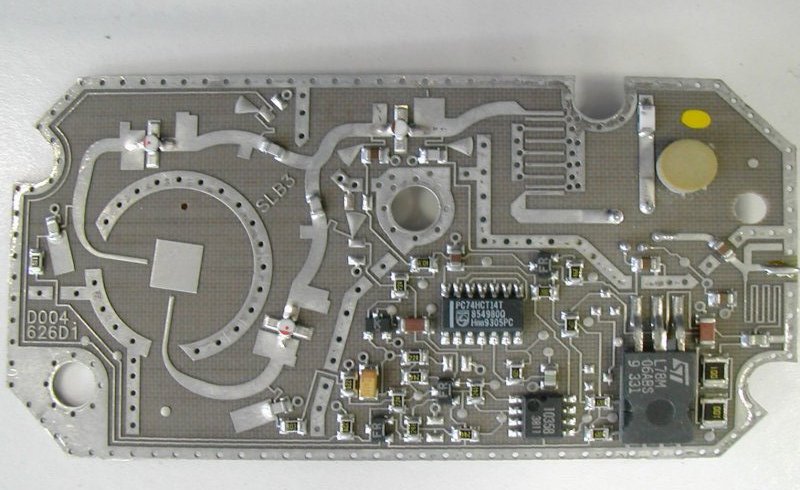Some Basics on the 10 GHz frequency range
Joachim Köppen Strasbourg Feb. 2007

Background material on radio telescopes on 12 GHz
- Class Room Radio Telescope
by M.Capitolo and W.Lonc is a good and detailed description of making and
operating an inexpensive telescope.
- Little Bitty Telescope is
a radio telescope also operating in the Ku band. It is less sophisticated
than the ESA-Dresden instrument, but the working principle is the same!
- Itty
Bitty Radio Telescope is an even smaller version of the Little Bitty.
-
Amateur radio telescope by Leon Ternoy works similarly to the
ESA-Dresden instrument, and is quite identical to the smaller dish I have been
using to observe the Sun in 2006. This article (in French) describes also
the electronics and the interior of the LNB.
- Article by D.Cleary JRASC 93, 40 (1999)
which describes the operation of a telescope just like the ESA-Dresden
instrument.
Radio waves at 12 GHz
Depending on their temperature, all bodies radiate electromagnetic radiation. The
spectrum is given by the black body or Planck function:
Flux = 2 h f^3/c² / (exp(hf/kT) - 1)
The maximum emission occurs at a wavelength which decreases with temperature.
The Sun - with a temperature of about 5700 K - has its maximum in the visible
range, at about 500 nm. Our own bodies - with a surface temperature of 30
centigrade or roughly 300 K - radiate mostly in the infrared, at 10µm. This
characteristic is formulated by Wien's displacement law which gives the
wavelength of maximum emission
λ_max = 5154μm/T
These bodies also give off radio waves: the intensity is much less than the
peak value. Its spectrum is described by the Rayleigh-Jeans approximation of the
black body curve (for hf << kT):
Flux = 2 f²k T /c²
So, the flux increases linearly with the temperature of the body, and quadratically
with frequency f. Because of this latter behaviour, the rather high frequency
of the Ku-band makes it easier to observe the photosphere of the Sun with radio
waves.
With the radio telescope - in fact already with only the LNB - we can pick up the
thermal radiation of our bodies: Hold the antenna opening of the LNB towards your
body, and the SatFinder will show a strong signal. However, in a room all bodies
are at room temperature, and thus pointing to anything, the furniture, the
floor, will result in the same signal level ... Outside the ground, houses, and
trees all give roughly the same strong signal. But only if we point the LNB toward
the sky, the indication will drop drastically ... at 12 GHz, the sky is dark,
while the ground is bright.
Experiment: If you point the LNB towards the sky, but behind the glass of
a window or a door, you find the same strong signal as if you point to the ground.
The explanation is smply that in the Ku-band glass is not transparent (This depends
on the type of glass, some are partially transparent)! Thus we observe nothing but
the thermal radiation from the warm glass! For this reason you cannot set up a TV
satellite dish inside your room. It must always be installed in the outside.
Sensitivity on Weather Conditions
At frequencies above about 10 GHz, the Earth atmosphere becomes progressively
less transparent, because the molecules of air are able to absorb this radiation
by converting the energy into rotation of the molecules. Water vapour plays a
rather important role, and thus the transmission of microwaves is sensitive
to the weather, especially the humidity. Thus, terrestrial and space communications
for shorter wavelengths become greatly impaired or even impossible. In the Ku-band
this absorption is not yet severe, but one can study this in a number of ways:
- measure the signal strength of the same TV satellite under various
weather conditions, such as under clear skies and under thick rain clouds.
- measure the signal from the Sun or the Moon under different elevation
angles and weather conditions. At low elevation the signals have to pass
a longer path through the Earth atmosphere.
- measure the signal from the empty sky at different elevation angles. The
thermal emission from the atmosphere is larger at low elevation, as there
is more atmospheric matter on the line of sight. The interpretation with
a simple model allows to measure the water content of the atmosphere,
as explained and shown here.
| Top of the Page
| Back to the MainPage
| to my HomePage
|
last update: Apr. 2013 J.Köppen

